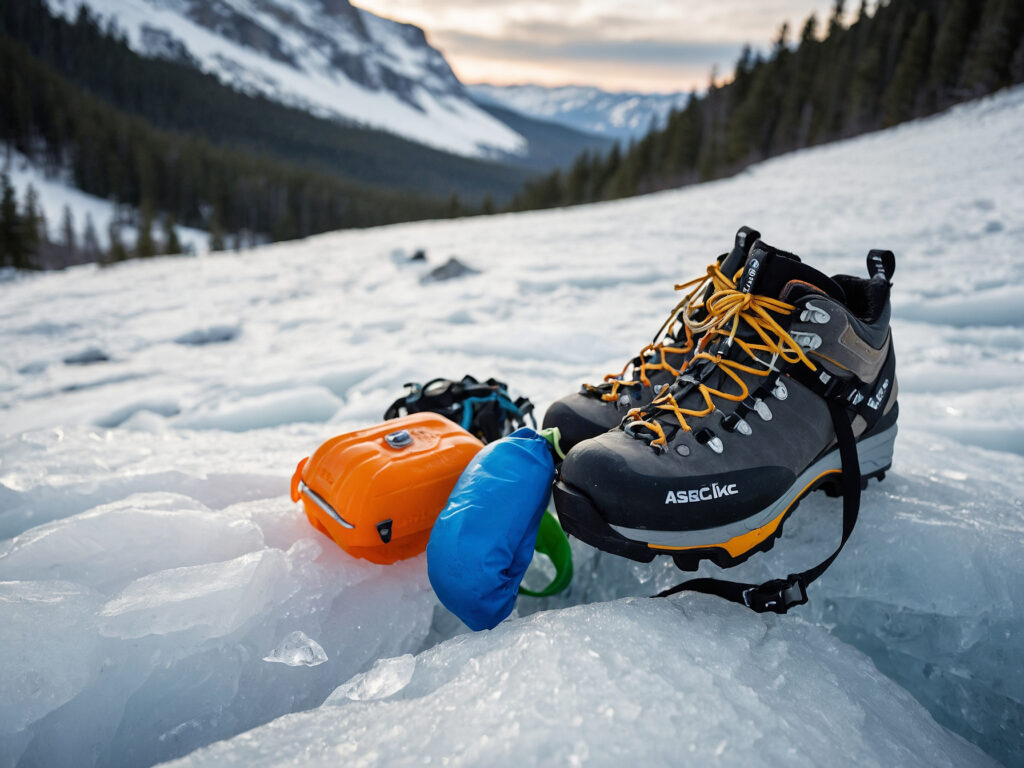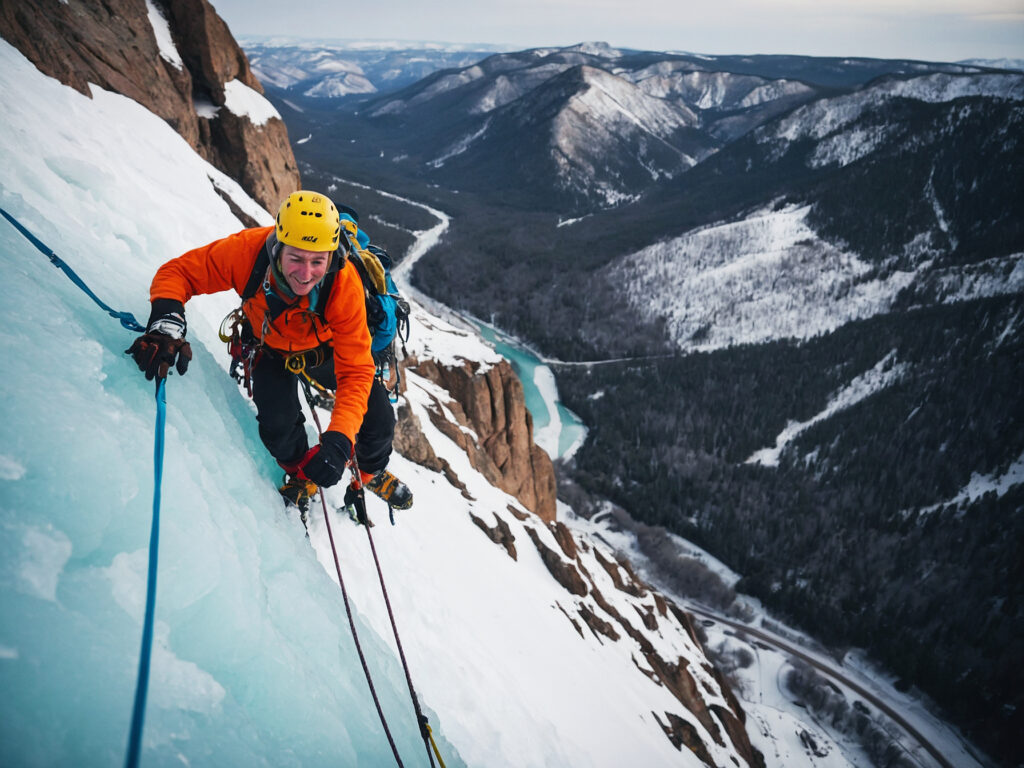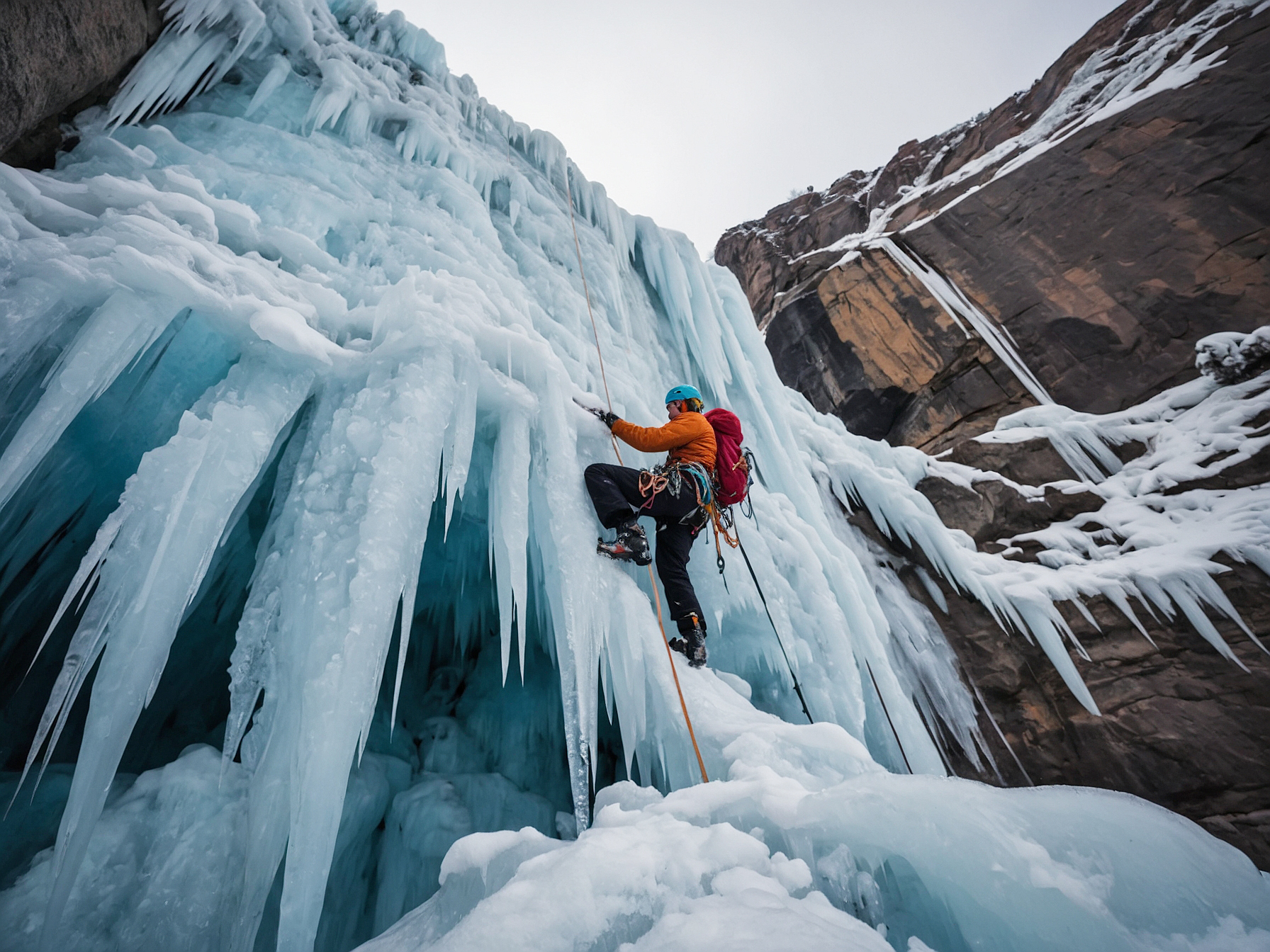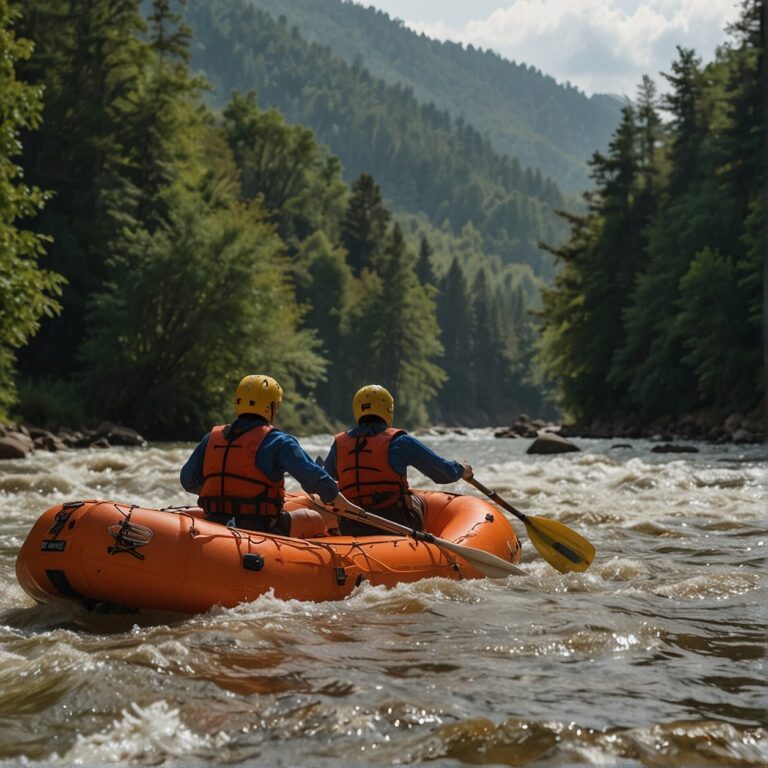Ice Climbing in Colorado’s Frozen Falls
Picture this: You’re decked out in your gear, ice axe in hand, staring up at a towering fortress of ice. The chill air nips at your face, but the excitement coursing through your veins keeps you warm. This isn’t just any winter adventure — you’re about to ascend a starkly beautiful, frozen waterfall in the heart of Colorado. Welcome to the exhilarating world of ice climbing!
“Ice climbing combines the thrill of scaling heights with the breathtaking beauty of nature in its harshest guise – a frozen winter landscape.”
Colorado, blanketed in pieces of nature’s winter artistry, calls every intrepid adventurer to climb its frozen formations. Here, the ice has a story to tell, filled with echoes of adventurers past and the tribute of their indomitable spirit. So, lace up your boots, zip up your parka, and come experience an adventure that will make your heartbeat resonate with the rhythm of the climb.
The Thrill of Ice Climbing: An Introduction
Picture this, you’re out in the wilds of Colorado, edges of your boots in firm contact with the slick ice beneath you. And suddenly, you’re off, climbing up a frozen waterfall, each breath a poignant reminder of the exciting challenge you’ve undertaken.
Ice climbing is more than just a frosty adventure – it’s a sport that tests your grit, discipline and safety skills. Imagine ascending up icy terrains, the crunch of ice beneath your gear, and the icy breeze cutting across your face; there’s a thrill to it that no indoor climbing wall can provide. It’s just you, the ice, and breathtaking views.
Each cascade you conquer becomes a part of you, a testament to your willpower, determination, and burgeoning skills in this exciting winter sport. As you steadily climb, you are not just ascending a physical edifice but also surmounting personal barriers, pushing your boundaries, and emerging stronger with each step.
And let’s not forget the sense of accomplishment at your final destination: on top of the world, with panoramic views that would leave even the most seasoned adventurers breathless.
Why Colorado is Your Next Ice Climbing Destination
Cradled within nature’s grand amphitheater, Colorado offers a sublime haven for ice climbing enthusiasts. Mere words might not do justice to the visual spectacle of the frozen waterfalls that dot the state, but let’s take a plunge into the scintillating world of ice climbing in Colorado.
Imagine a crystalline, gleaming wall of ice in front of you. Imagine the thrill of conquering it, equipped with nothing but an axe and a sense of belay. As you ascend, you are at one with the raw, pulsating heart of winter. The crackle of ice under your gear, the whispers of the wind – it’s an exhilarating symphony of nature’s hushed tones. That, dear reader, is the magic of ice climbing in Colorado.
While the state is renowned for its ski slopes, ice climbing has emerged as a compelling adventure sport that equally draws thrill-seekers to its icy landscapes. Keystone, Ouray, Vail – just to name a few – are Colorado’s famed ice climbing regions, each with its unique charm and challenges. As you carve your path up these ice walls, you’re not just climbing; you’re leaving an imprint on a dynamic canvas that reshapes with each passing season.
The frozen waterfalls of Colorado are a sight to behold. They morph from serene cascades during summer to colossal icy structures in winter, creating an ideal playground for climbers. Furthermore, ice climbing in Colorado isn’t only about physicality; it’s also a mental game. Managing your momentum, calculating each move, and battling the occasional wave of fear that hits when you look down – every climb is a lesson in endurance and strategy.
Whether you’re a seasoned climber or a curious amateur, Colorado extends a welcoming hand. Ice climbing here ranges from entry-level climbs to steep, challenging ascents that can test even the most experienced of climbers. So, what are you waiting for? It’s time to embark on your ice climbing adventure in the heart of Colorado.
Ice Climbing Essentials: What You Need to Know
So, you’ve decided to take the plunge into the spellbinding world of ice climbing; it’s time to familiarize yourself with the essentials. When we talk about essentials, we’re not only referring to equipment but also necessary skills and precautions. Let’s dive in!

The Ice Climbing Kit
Outfitting yourself for an ice climbing trip begins with acquiring the correct gear. Your kit should include quality ice climbing boots, crampons for improved mobility on icy surfaces, ice axes for balance and traction, a climbing harness, carabiners, ropes, and a helmet for absolute safety. The last thing you want is inferior gear when you’re hanging on a vertical mass of ice! Make sure to consult an expert or a reliable outfitter when assembling your gear.
Skills to Master
Ice climbing isn’t just about having the right gear; it’s equally essential to possess the right skills. Training for strength and endurance is a prerequisite, even if you’re a seasoned hiker or rock climber. Along with physical conditioning, practice the sport in a controlled environment, preferably under the supervision of an expert trainer. Key techniques such as front pointing and flat footing, as well as understanding ice quality and potential risks, are crucial for a successful climb.
Safety First
Ice climbing is undoubtedly thrilling, yet it comes with its share of risks. Hence, safety should always be your paramount concern. Learn how to make the vital checks on your equipment before each ascent. Understand the indications of potential icefalls, and take a course in mountaineering first aid. Climbing with a buddy is highly recommended, as an extra set of eyes can spot dangers you may overlook. No venture is too insignificant for a comprehensive safety measure.
To conclude, preparation is the key when it comes to ice climbing. Equipping yourself with the right kit, mastering essential skills, and prioritizing safety are integral elements to an unforgettable, exciting, and safe ice climbing journey in Colorado, or anywhere else.
Harvesting the Ice: A Beginner’s Guide to Ice Climbing
Firstly, let’s get one thing straight, ice climbing is not your run-of-the-mill type of sport. It demands a certain level of bravery to face the sheer vertical walls of ice. But don’t let that deter you! As a beginner, the sensation of hacking away at the frozen façade with your ice axe, progressing upward with every sturdy kick of your crampon-clad feet, is an experience you wouldn’t want to miss. This, my friends, is what we call ‘harvesting the ice’.
So, are you ready to get your feet – rather, your crampons – wet? Let’s dive into the basics. What you need, first and foremost, is to understand the ice formations. Frozen waterfalls, which you’ll find in plenty across Colorado’s ice-laced landscape, make for ideal climbing venues. In winter they transform into glittering cascades, their surfaces a varying mix of brittle, hard, or ‘plastic’ ice, each type having its distinct climbing technique.
You’ll also need to come to grips with the gear involved in ice climbing. No, we don’t mean a cozy pair of gloves and a hot cup of cocoa – we’re talking the real, serious stuff: crampons, ice axes, ropes, and harnesses. Mastering each piece of your climbing kit is vital to your safety and success as an ice climber.
A necessary skill on your beginner’s checklist should be reading the ice features and understanding its varying properties. Just as you anticipate the road when you drive, in ice climbing, you learn to read the ice you climb. Look for the tell-tale signs: narrow lines, indentations, and bulges. They can guide you towards the safest and most efficient path up the waterfall. What seemed like a cold, unyielding wall of ice will soon start to reveal its secrets to you.
Above all, ice climbing, like any other adventurous outdoor sport, is about respect – for the environment, for the gear, for the ice itself, and, not least, for ourselves. So, as you embark on this exciting journey, remember to climb responsibly, stay safe, and, most importantly, to enjoy every moment of it.
Navigate the Ice: Safety Measures for Climbing Frozen Waterfalls
Ice climbing might seem intimidating at first glance but when armed with the right information, it can be safely enjoyed. Navigating the ice is a skill that requires focus, agility and a good understanding of safety measures, especially when climbing frozen waterfalls in the stunning landscapes of Colorado.
First and foremost, proper equipment is crucial. Without a solid crampon-foot connection, the risk of slipping on the ice increases significantly. Keeping your ice tools sharp ensures efficient ice penetration and decreases the chances of tool bounce. Additionally, helmets, harnesses and ropes form a vital part of your safety gear. Make sure they meet the appropriate safety standards and are in good condition before you set out.
Risk assessment is another key factor to consider while planning your ice climbing adventure. Be on the lookout for overhead hazards including cornices and icicles that can break off. Furthermore engaging a local guide can prove invaluable. Their deep knowledge of the terrain and the current conditions, helps mitigate risks.
Lastly, the importance of communication cannot be overstated. Effective communication with your climbing partner ensures that both of you understand the route, the associated risks, and the plan in case of an emergency. Keep in mind, safety is a shared responsibility when climbing in a team.
Ice climbing involves dealing with unpredictable elements of nature. Therefore, it’s important to regularly update your knowledge about avalanche safety, ice conditions, and emergency rescue procedures. Online courses, books, and workshops are fantastic resources to become a well-educated ice climber.
Remember, a successful ice climbing adventure involves more than just reaching the top– it’s also about ensuring your safety and the safety of your team in these unparalleled natural arenas. Be prepared, stay vigilant, and you’re sure to enjoy the ethereal beauty of Colorado’s frozen waterfalls.
FAQ’S
Before we venture any further up the icy slopes, let’s pause for a moment to address some of the burning questions you may have about this frosty pursuit. Our FAQ section comprises inquiries commonly made by both beginners and practicing climbers looking to take on the frozen waterfalls of Colorado. So, strap on your crampons, secure your ice axes, and let’s explore these ice climbing queries together.
What are the best months for ice climbing in Colorado?
The optimal time for ice climbing in Colorado typically falls between late December and early March, although this can vary slightly depending on the weather conditions each year. During these months, Colorado’s winter transforms the landscape into a white wonderland, with the cascading waterfalls freezing over to create a beautiful, icy spectacle. These conditions provide the perfect environment for ice climbing adventures.
However, it’s critical to remember that the weather in Colorado can be unpredictable. Despite the season, the temperatures can fluctify enormously, affecting the condition of the ice. So, always be prepared for sudden weather shifts and consult local climbing guides or meteorological services for updated weather forecasts.
Another important note is that weekdays can often be less crowded on the icefalls, making it a more enjoyable experience for you. Plus, planning your trip around holidays or local ice climbing festivals might add an extra layer of thrill to your adventure, allowing you to connect with the vibrant Colorado ice climbing community.
Ultimately, whichever month you choose, ensure you’re prepared, stay safe, and embrace the marvels of ice climbing in the magical, frost-covered Colorado.

How do I get started with ice climbing?
Starting your ice climbing adventure might seem overwhelming at first, but it doesn’t have to be. An ideal first step would be to enroll in an ice climbing course. This course could be a day-long, weekend-long, or even a week-long program, widely offered by many climbing gyms and outdoor adventure services in Colorado. These courses will guide you through the basics of rope handling, ice tool placement, and how to properly wear and use crampons.
After you’ve mastered the basics, you can move on to gaining actual ice climbing experience. It’s advisable to practice at a reputable ice climbing park before heading out to frozen waterfalls in the wilder parts of Colorado. Many parks provide routes at different gradients and levels of difficulty, making it a safe and controlled environment to perfect your skills.
Once you’re ready, you can then venture out into the scenic landscapes Colorado offers. To do this safely, consider climbing with an experienced guide or joining a local climbing club. Here you can learn safety skills such as evaluating ice conditions or setting up emergency shelters. These clubs also offer opportunities to connect with other climbers and foster a sense of community.
Also, always remember the importance of having the right gear. Ice climbing gear can be expensive, so make sure you do your research and invest in quality equipment that will last. Renting equipment is also a great option when starting out.
Now, don’t forget, ice climbing doesn’t come without risks. Be sure to also take every precaution, focus on your skills, gain experience and, most importantly, respect the icy environment you’re venturing into. Ice climbing can be a challenge, but with the right preparation, practice, and mindset, it can also be an exhilarating adventure waiting for you in beautiful Colorado.
What is the difficulty level of ice climbing in Colorado?
Ice climbing in Colorado can range from relatively low to high difficulty levels, based on your skills, experience, and the specific location you choose. As you can imagine, this sport isn’t a one-size-fits-all activity. It’s important to gauge your individual readiness for the extreme weather conditions, potentially strenuous physical activity, and the technical precision required for climbing ice formations.
For beginners, there are several guided tours with experienced professionals. These will introduce you to the activity by familiarizing you with the equipment and teaching basic climbing techniques on smaller, less intimidating ice formations. You can expect a low to moderate challenge on these beginner-friendly sites, with safety measures firmly in place.
For the more experienced climbers seeking a greater challenge, ice routes like ‘The Fang’ and ‘Mean Green’ can offer a strenuous and thrilling climb. These routes have steep ice walls and require more strength and expertise. They will test your skills to the limit.
Remember, ice climbing is more than just the climb itself. It also involves negotiating difficult terrains and managing unpredictable weather conditions. While it can be challenging and intense, with the right training and preparation, ice climbing in Colorado can be an exceptionally rewarding experience.
What are the emergency services available in case of an accident while ice climbing?
While hoping for the best, it’s crucial to prepare for the worst. Colorado is home to several emergency responses and rescue services designed to provide help when you need it most.
Top is the search and rescue (SAR) teams often led by the county sheriff’s office across Colorado. SAR teams comprise dedicated volunteers trained in wilderness first aid, high-angle rescue, winter survival skills, and incident command. Pertinently, they are familiar with the icy terrains and equipped to navigate them during emergencies.
Next on the list, the ski patrollers at winter resorts offer first aid and evacuation services for any mishap on the ice. They are highly skilled, often possessing certifications in winter rescue and wilderness first aid.
Emergency medical services (EMS) are also available across the state. They can be quickly called to the scene of an accident to provide medical care and transportation to a nearby medical facility when required.
In case of extreme accidents, some areas in Colorado also have air ambulance services that can transport you rapidly to the nearest trauma center. However, remember that these services may come at a significant cost.
You’re encouraged to carry a fully charged mobile device, GPS, or at least a whistle to signal for help in case of an accident. Also, consider investing in a Personal Locator Beacon (PLB) or a satellite messenger to increase your safety. They enable you to send an emergency distress signal with your exact coordinates to rescuers, no matter where you might be.
I can’t stress enough how important it is to be cognizant of these services while planning your ice-climbing adventure. More crucially, do your best to avoid needing them in the first place by following all the safety guidelines, ensuring you’re properly equipped, and heeding the weather-resistant capabilities of your body.
Can beginners try ice climbing in Colorado?
Absolutely! Colorado is an excellent destination for beginners who wish to venture into the exhilarating world of ice climbing. Why, you ask? Let’s explore.
For starters, Colorado is home to some of the world’s most respected ice climbing schools. These schools offer courses designed specifically for beginners, creating a safe and supportive environment for newcomers to learn the ropes. Whether you’re getting familiar with the basic equipment or practicing your first ascent, expert instructors guide you every step of the way. These establishments prioritize safety, ensuring learners are well-equipped with the right knowledge before making their first climb.
Additionally, Colorado’s diverse terrain provides a unique advantage. Its vast array of ice-climbing sites varies in difficulty levels, meaning there’s something for everyone. As a beginner, you’ll likely start on smaller, less challenging icefalls where you can gradually improve your technique and build confidence. This variety paves the way for a continual journey in ice climbing, giving you the opportunity to progress at your own pace.
Finally, the warm and inclusive Colorado climbing community contributes a lot to a positive beginner experience. Many experienced climbers are happy to share advice, tips, and even their favorite climbing spots – a wonderful way to learn and grow in your newfound passion. So yes, beginners can definitely dip their toes into the icy waters of ice climbing in Colorado.







